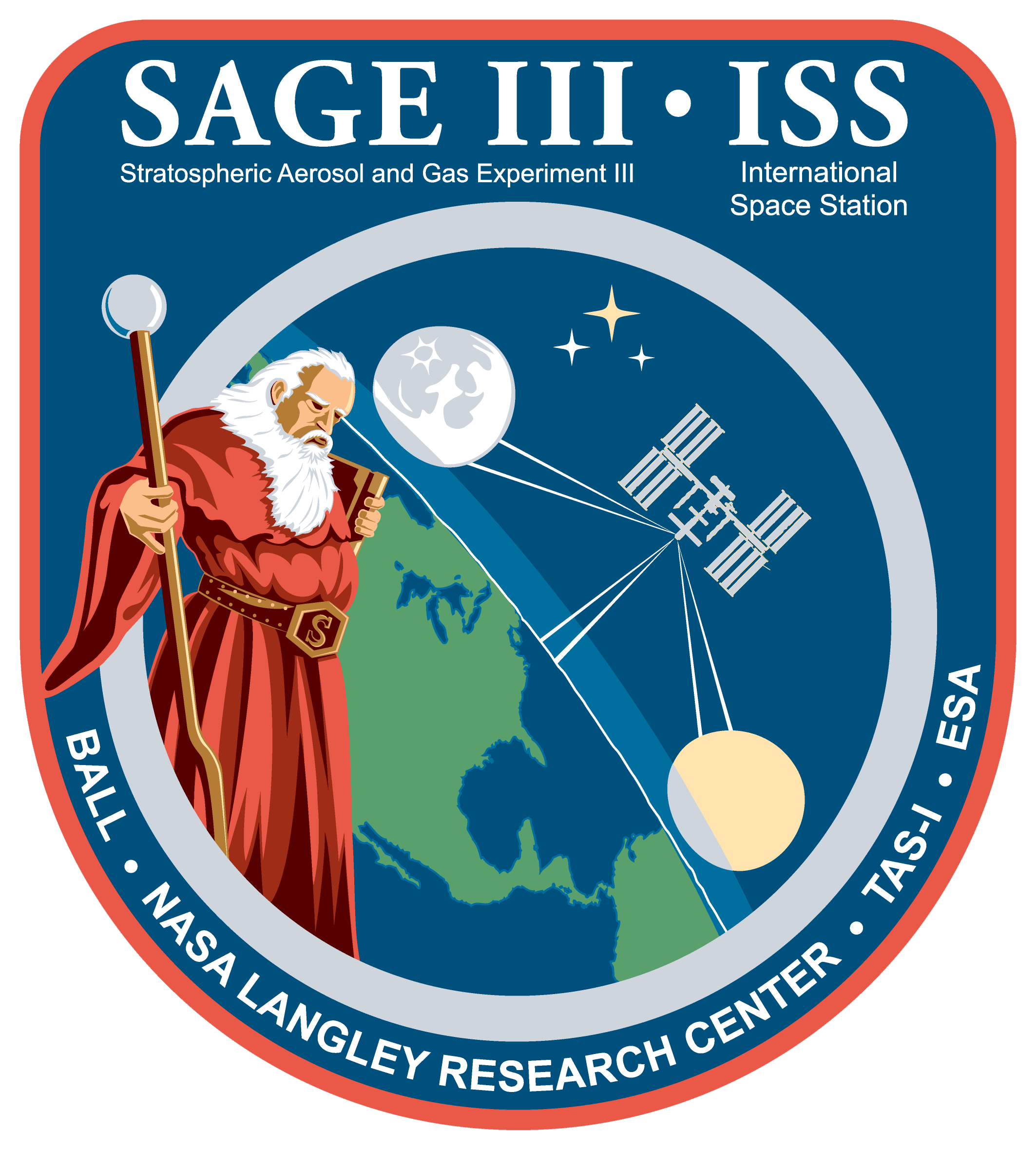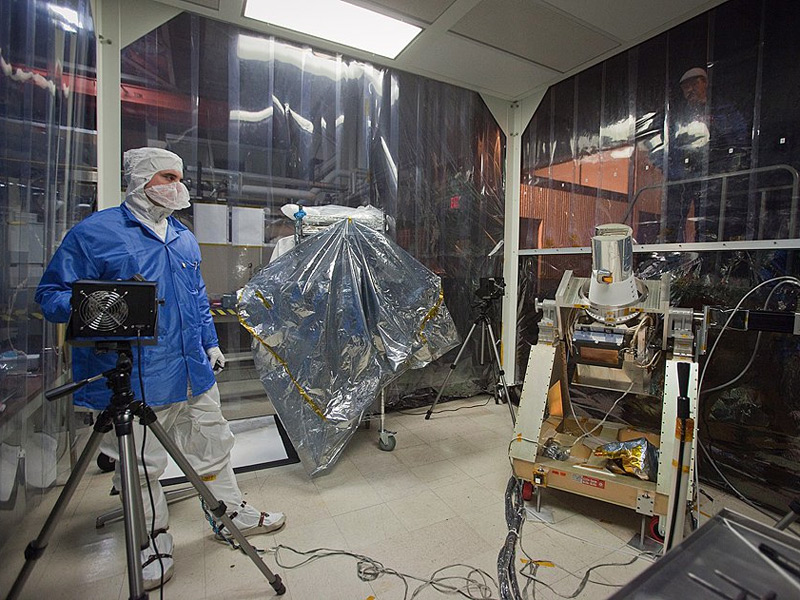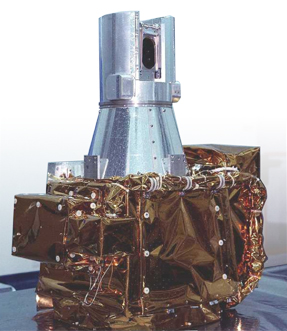SAGE III on ISS on:
[Wikipedia]
[Google]
[Amazon]
 SAGE III on ISS is the fourth generation of a series of NASA Earth-observing instruments, known as the
SAGE III on ISS is the fourth generation of a series of NASA Earth-observing instruments, known as the

 The SAGE III mission is an important part of NASA's Earth Observation System and is designed to fulfill the primary scientific objective of obtaining high quality, global measurements of key components of atmospheric composition and their long-term variability. The primary focus of SAGE III on ISS will be to study aerosols, clouds, water vapor, pressure and temperature, nitrogen dioxide, nitrogen trioxide, and chlorine dioxide.
The SAGE III mission is an important part of NASA's Earth Observation System and is designed to fulfill the primary scientific objective of obtaining high quality, global measurements of key components of atmospheric composition and their long-term variability. The primary focus of SAGE III on ISS will be to study aerosols, clouds, water vapor, pressure and temperature, nitrogen dioxide, nitrogen trioxide, and chlorine dioxide.
 Ozone research has remained at the forefront of atmospheric science for many years because stratospheric ozone shields the Earth's surface (and its inhabitants) from harmful ultraviolet radiation. Since recent declines in stratospheric ozone have been linked to human activity, accurate long-term measurements of ozone remain crucial.
It is important to monitor ozone levels in the lower stratosphere and upper troposphere since observed trends are the largest and most poorly understood at those altitudes. SAGE III's high vertical resolution and long-term stability make it uniquely well suited to make these measurements. SAGE III is also able to look at the relationship between aerosol, cloud, and chemical processes affecting ozone argue for simultaneous measurements of these atmospheric constituents (such as those made by SAGE III).
Ozone research has remained at the forefront of atmospheric science for many years because stratospheric ozone shields the Earth's surface (and its inhabitants) from harmful ultraviolet radiation. Since recent declines in stratospheric ozone have been linked to human activity, accurate long-term measurements of ozone remain crucial.
It is important to monitor ozone levels in the lower stratosphere and upper troposphere since observed trends are the largest and most poorly understood at those altitudes. SAGE III's high vertical resolution and long-term stability make it uniquely well suited to make these measurements. SAGE III is also able to look at the relationship between aerosol, cloud, and chemical processes affecting ozone argue for simultaneous measurements of these atmospheric constituents (such as those made by SAGE III).
 SAGE III was launched on the SpaceX CRS-10 mission using a Falcon 9 with
SAGE III was launched on the SpaceX CRS-10 mission using a Falcon 9 with
NASA.gov
NASA.gov
SAGE III on ISS
at NASA.gov
by Langley Research Center
International Space Station experiments Satellite meteorology Aerosol measurement
 SAGE III on ISS is the fourth generation of a series of NASA Earth-observing instruments, known as the
SAGE III on ISS is the fourth generation of a series of NASA Earth-observing instruments, known as the Stratospheric Aerosol and Gas Experiment
The Stratospheric Aerosol and Gas Experiment (SAGE) is a series of remote sensing satellite instruments used to study the chemical composition of Earth's atmosphere. Specifically, SAGE has been used to study the Earth's ozone layer and aerosols a ...
. The first SAGE III instrument was launched on a Russian Meteor-3M satellite. The recently revised SAGE III was mounted to the International Space Station where it uses the unique vantage point of ISS to make long-term measurements of ozone, aerosols
An aerosol is a suspension of fine solid particles or liquid droplets in air or another gas. Aerosols can be natural or anthropogenic. Examples of natural aerosols are fog or mist, dust, forest exudates, and geyser steam. Examples of anthrop ...
, water vapor, and other gases in Earth's atmosphere.
History of the SAGE legacy
The first SAGE instrument was launched on 18 February 1979, to collect data on the various gases in the atmosphere, including ozone. The data collected on SAGE I and the following instrument SAGE II, which began taking measurements in October 1984, were critical to the discovery of the Earth's ozone hole and the creation of 1987 Montreal Protocol, which banned ozone-depleting substances, such as chlorofluorocarbon (CFC). SAGE III on ISS is a nearly exact replica of SAGE III, on Meteor-3M, sent into orbit in 2001 on a Russian satellite. SAGE III on Meteor-3M went out of service in March 2006 when the satellite's power supply stopped working. The new instrument was built in anticipation of being attached to the space station in 2005. A change in ISS design, however, put those plans on hold. The instrument was stored in a Class 100 clean room in a sealed shipping container under a continuous gaseous nitrogen purge. The purge kept clean dry "air" inside the instrument. Recently, the opportunity arose for SAGE III to be placed on ISS, and build on the long record of stratospheric gas data that its ancestors created. The week of 14 February 2011, scientists at NASALangley Research Center
The Langley Research Center (LaRC or NASA Langley), located in Hampton, Virginia, United States of America, is the oldest of NASA's field centers. It directly borders Langley Air Force Base and the Back River on the Chesapeake Bay. LaRC has fo ...
pulled the instrument from storage to begin initial testing and calibrations in preparation prepping it for launch.

Science behind SAGE III on ISS
The SAGE III instrument is a gratingspectrometer
A spectrometer () is a scientific instrument used to separate and measure spectral components of a physical phenomenon. Spectrometer is a broad term often used to describe instruments that measure a continuous variable of a phenomenon where the ...
that measures ultraviolet and visible energy. It relies upon the flight-proven designs used in the Stratospheric Aerosol Measurement (SAM I) and first and second SAGE instruments. The SAGE III design incorporates charge-coupled device (CCD) array detectors and a 16 bit A/D converter. Combined, these devices allow for wavelength calibration, a self-consistent determination of the viewing geometry, lunar occultation measurements, and expanded wavelength coverage.
The SAGE III sensor assembly consists of pointing and imaging subsystems and a UV/visible spectrometer. The pointing and imaging systems are employed to acquire light from either the Sun or Moon by vertically scanning across the object. The spectrometer uses an 800 element CCD linear array to provide continuous spectral coverage between 290 and 1030 nm. Additional aerosol information is provided by a discrete photodiode at 1550 nm. This configuration enables SAGE III to make multiple measurements of absorption features of target gaseous species and multi-wavelength measurements of broadband extinction by aerosols.
Atmospheric components studied by SAGE III on ISS
 The SAGE III mission is an important part of NASA's Earth Observation System and is designed to fulfill the primary scientific objective of obtaining high quality, global measurements of key components of atmospheric composition and their long-term variability. The primary focus of SAGE III on ISS will be to study aerosols, clouds, water vapor, pressure and temperature, nitrogen dioxide, nitrogen trioxide, and chlorine dioxide.
The SAGE III mission is an important part of NASA's Earth Observation System and is designed to fulfill the primary scientific objective of obtaining high quality, global measurements of key components of atmospheric composition and their long-term variability. The primary focus of SAGE III on ISS will be to study aerosols, clouds, water vapor, pressure and temperature, nitrogen dioxide, nitrogen trioxide, and chlorine dioxide.
Aerosols
Aerosols play an essential role in the radiative and chemical processes that govern the Earth's climate. Since stratospheric aerosol loading has varied by a factor of 30 since 1979, long-term monitoring of tropospheric and stratospheric aerosols is crucial. SAGE III aerosol measurements will provide important contributions in the area of aerosol research.Clouds
Clouds play a major role in determining the planet's solar and longwave energy balance and, thus, are important in governing the Earth's climate. SAGE III will provide measurements of mid and high level clouds including thin or "sub-visual" clouds that are not detectable by nadir-viewing passive remote sensors. These observations are important because while low clouds primarily reflect incoming solar radiation back into space (acting to cool the planet), mid and high level clouds enhance the " greenhouse effect" by trapping infrared radiation (acting to warm the planet). Also, the presence of thin cloud near the tropopause may play a significant role in heterogeneous chemical processes that lead toozone destruction
Ozone depletion consists of two related events observed since the late 1970s: a steady lowering of about four percent in the total amount of ozone in Earth's atmosphere, and a much larger springtime decrease in stratospheric ozone (the ozone la ...
in mid-latitudes.
Water vapor
Water vapor is the dominant greenhouse gas and plays a crucial role in regulating the global climate system. An improved understanding of the global water vapor distribution can enhance our ability to understand water's role in climate processes. SAGE III water vapor measurements will provide important contributions on the long-term effect of this green house gas.Ozone
 Ozone research has remained at the forefront of atmospheric science for many years because stratospheric ozone shields the Earth's surface (and its inhabitants) from harmful ultraviolet radiation. Since recent declines in stratospheric ozone have been linked to human activity, accurate long-term measurements of ozone remain crucial.
It is important to monitor ozone levels in the lower stratosphere and upper troposphere since observed trends are the largest and most poorly understood at those altitudes. SAGE III's high vertical resolution and long-term stability make it uniquely well suited to make these measurements. SAGE III is also able to look at the relationship between aerosol, cloud, and chemical processes affecting ozone argue for simultaneous measurements of these atmospheric constituents (such as those made by SAGE III).
Ozone research has remained at the forefront of atmospheric science for many years because stratospheric ozone shields the Earth's surface (and its inhabitants) from harmful ultraviolet radiation. Since recent declines in stratospheric ozone have been linked to human activity, accurate long-term measurements of ozone remain crucial.
It is important to monitor ozone levels in the lower stratosphere and upper troposphere since observed trends are the largest and most poorly understood at those altitudes. SAGE III's high vertical resolution and long-term stability make it uniquely well suited to make these measurements. SAGE III is also able to look at the relationship between aerosol, cloud, and chemical processes affecting ozone argue for simultaneous measurements of these atmospheric constituents (such as those made by SAGE III).
Pressure and temperature
SAGE III temperature measurements will provide a unique data set for monitoring and understanding atmospheric temperature changes. In particular, the long-term stability and self-calibration capabilities of SAGE III may permit the detection of trends in stratospheric and mesospheric temperature that will be important diagnostics of climate change. SAGE III temperature measurements in the upper stratosphere and mesosphere will be a new source of long-term temperature measurements in this region of the atmosphere to complement existing long-term measurements made by satellites (MLS, ACE, SABER) and ground based lidar systems. SAGE III temperature measurements will also allow the monitoring of periodic temperature changes, such as those associated with the solar cycle and quasi-biennial oscillation, and the effects of radiative forcing by aerosols.Nitrogen dioxide, nitrogen trioxide, and chlorine dioxide
Nitrogen dioxide (NO2),nitrogen trioxide
Trioxidonitrogen(•) or nitrate radical is an oxide of nitrogen with formula , consisting of three oxygen atoms covalent bond, covalently bound to a nitrogen atom. This highly unstable blue compound has not been isolated in pure form, but can be ...
(NO3), and chlorine dioxide (OClO) play crucial roles in stratospheric chemistry and the catalytic cycles that destroy stratospheric ozone. SAGE III nitrogen dioxide measurements are important because the processes that occur in the Antarctic winter and spring and give rise to the ozone hole effectively convert NO2 to nitric acid (HNO3). Thus NO2 is an important diagnostic of ozone hole chemistry. Since it is measured during both solar and lunar occultation events, SAGE III observations of NO2 will improve our understanding of the strong diurnal (daily) cycles in stratospheric processes. In addition, SAGE III will make virtually unique measurements of nitrogen trioxide (NO3). Although it is short-lived in the presence of sunlight, NO3 plays an active role in the chemistry of other reactive nitrogen species such as NO2 and di-nitrogen pentoxide (N2O5) and, thus, indirectly in ozone chemistry. Since few other measurements of NO3 are available, SAGE III measurements, which are made during lunar occultation (nighttime) events, will provide crucial validation for our current understanding of reactive nitrogen chemistry.
Launch
 SAGE III was launched on the SpaceX CRS-10 mission using a Falcon 9 with
SAGE III was launched on the SpaceX CRS-10 mission using a Falcon 9 with Dragon
A dragon is a reptilian legendary creature that appears in the folklore of many cultures worldwide. Beliefs about dragons vary considerably through regions, but dragons in western cultures since the High Middle Ages have often been depicted as ...
. SAGE III traveled in the unpressurized trunk of Dragon, which launched on 19 February 2017. Upon arrival, NASA used Dextre to berth the instrument onto an ExPRESS Logistics Carrier platform on the ISS.
International partners
NASA Langley Research Center, based out ofHampton, Virginia
Hampton () is an independent city (United States), independent city in the Commonwealth (U.S. state), Commonwealth of Virginia in the United States. As of the 2020 United States Census, 2020 census, the population was 137,148. It is the List ...
, is leading the SAGE III mission. Ball Aerospace & Technologies Corp. built the SAGE III-ISS instrument in Boulder, Colorado
Boulder is a home rule city that is the county seat and most populous municipality of Boulder County, Colorado, United States. The city population was 108,250 at the 2020 United States census, making it the 12th most populous city in Color ...
, and the European Space Agency
, owners =
, headquarters = Paris, Île-de-France, France
, coordinates =
, spaceport = Guiana Space Centre
, seal = File:ESA emblem seal.png
, seal_size = 130px
, image = Views in the Main Control Room (1205 ...
(ESA) and Thales Alenia Space- Italy (TAS-I), headquartered in France, are providing a hexapod to keep the instrument pointing in the right direction as the ISS maneuvers in space.
Notes
{{Reflist, 30emReferences
NASA.gov
NASA.gov
External links
SAGE III on ISS
at NASA.gov
by Langley Research Center
International Space Station experiments Satellite meteorology Aerosol measurement